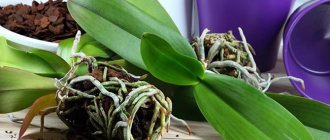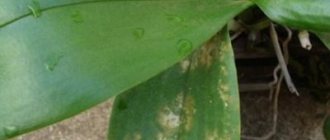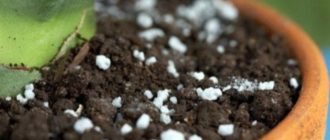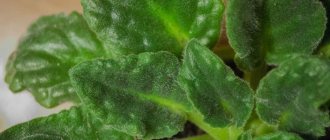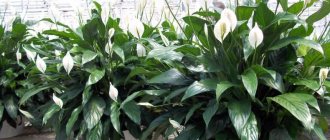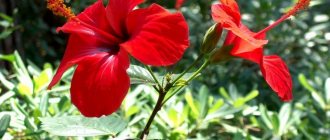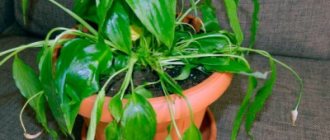Houseplant Calathea - description
From Latin the name “calathea” is translated as “basket”. This name is not because the indoor flower itself looks like a basket, but because of the leaf veins. They are dense and thick, so in ancient Greece they were actually used for weaving baskets.
Calathea belongs to the arrowroot family, and therefore, like all representatives of this family, it loves moisture very much. Perennial. Nowadays it is no longer used for weaving baskets, but is used for decorating rooms: it has large, beautiful leaves, and breeders have developed various varieties - with red leaves, pink leaves, pink veins and many other various decorations.
Calathea is beautiful, but rather capricious in terms of moisture levels. But it also has a positive feature: unlike many ornamental plants, it prefers shade rather than sun.
It is also known as the flower that raises its leaves at night. This is true: at night its leaves curl, and in the morning they bloom again. Because of this, she got the nickname “prayer flower”: as if he prays in the evenings and mornings.
What does calathea look like?
The plant is quite large, sometimes even resembling not a flower, but a tree: it reaches eighty centimeters in height, and the leaves are large, round, up to thirty centimeters in length. They grow in several stems-shoots from one rhizome.
The colors of the leaves can be very different, since there are many varieties of decorative calathea. Breeders also try to develop varieties with different patterns on the leaf blades, so two plants belonging to the same calathea species can look completely different.
Where it grows - the birthplace of the plant
Central and South America, shady, humid tropics.
How indoor calathea blooms
As with many plants whose main decorative value is their leaves, potential owners have the question “does calathea bloom or not at all?” Of course it blooms.
Flowering time: late spring, summer. The flowers are small, collected in small delicate spikelets, and come in pink, white, purple, orange and other colors.
Is Calathea poisonous or not?
It has poisonous juice. However, in Asian countries, the leaves of this plant are even used as plates, they wrap food in them, so calathea is absolutely safe - you are not going to chew the leaves to get juice from them. But you should not allow animals or children near the plant - they are not so prudent.
Other names for Calathea
The botanical name - Calathea - has become very widespread not only in the scientific community, but also in life.
INTERESTING. The name of this flower comes from the Greek word “calathos”, which literally means “basket”. The fact is that in ancient times baskets were woven from Calathea leaves.
But, perhaps, you can find another equally popular name for this flower. It is often called a prayer tree . Thanks to special pads located in the thickenings of the leaf petioles, Calathea has the ability to turn the foliage according to the movement of the sun.
But the main feature that the ancients noticed and why they dubbed the flower a prayer flower is the ability to lift and join the leaves together before rain or in the evening after sunset.
This action looks as if the flower is folding its leaves-palms in a prayer gesture.
How to care for Calathea at home
Caring for calathea is not too difficult; the most labor-intensive thing here is to provide the required level of humidity. Here are the factors you need to consider.
Replanting after purchase
Optional, but desirable, since it is unknown what is contained in store-bought soil (and it is usually scanty), and if you replant the flower, you will know for sure. Transplantation after purchase is no different from the usual one, described in the corresponding section below.
Please note that if a new pet blooms, it is better not to replant - flowering will immediately stop due to stress, so wait until it is finished. It is also better not to replant in winter, but to wait until at least early spring.
Lighting
Soft, diffused, partial shade desirable. Completely artificial lighting is not suitable; the calathea should receive sunlight, but only indirect light - it easily gets sunburned. If you put it on the balcony, be sure to block it from the sun with at least a curtain.
Temperature
The range of acceptable temperatures is quite wide: 16-24⁰С. Drafts and sudden changes in temperature (for example, suddenly opening a window in cold weather) are unacceptable; they lead to leaf rot.
Humidity
Very high is required, up to 90%. How to ensure this humidity:
- If you have a variety with glossy, smooth leaves, then wipe the flower every day with wet wipes, put it in the shower, and spray it (only warm water).
- If the variety has velvety, fleecy leaves, place the pot in a tray with wet pebbles (the pebbles should lie around, the bottom of the pot does not come into contact with them) and make sure that they are always wet. Be sure to wipe the leaves with a dry cloth to remove dust.
- Place in an aquarium or florarium.
- Keep away from heating devices. Calathea tolerates lack of light more easily than too dry air.
How to water a calathea
It is quite capricious regarding water quality and does not tolerate traces of lime. The water should be soft, ideally melt or rain. If it is not possible to water one, then the night before watering, you need to place peat wrapped in cloth in the water so that it disinfects and softens the water, and water it the next morning.
Do not let water drop on the leaves when watering, because if the wet leaves are then exposed to the sun, they will cause sunburn. Also, do not forget to drain the water from the pan to prevent rotting of the roots.
In summer
Two to three times a week.
in winter
Watering is reduced to once a week due to the fact that moisture evaporates more slowly.
Fertilizer and feeding
Feed from April to August, twice a month. Saffron calathea is fertilized with fertilizer for ornamental flower plants, and all other types - for plants with decorative foliage. There should be no nitrogen and calcium in the fertilizing. The dose of fertilizing is reduced by half from that indicated on the package.
Calathea turns yellow
The lower leaves on the bush turn yellow and die over time. Instead, new, young leaves then appear. This is a natural process for the plant. But if the leaves turn yellow on the entire flower, then the reasons may be:
· the plant is cold;
· overdose of fertilizers;
· too frequent or, conversely, insufficient watering.
Do not forget that the flower requires warmth, fertilizing only in spring and summer with low concentration fertilizers and always slightly moistened soil.
If watering is frequent or water stagnates in the tray, the roots of the plant will begin to rot, which is why the leaves turn yellow. Such a bush will need to be transplanted into new soil, after cutting off the rotten roots. Before planting, the cuttings must be sprinkled with crushed coal.
Reproduction of calathea at home
Calathea can be propagated by cuttings (including leaves), dividing the bush or planting seeds. For the first three methods, you will need to perform a small surgical operation - to separate part of the plant. Therefore you will need:
- A sharp tool – scissors or a knife. They must be well sharpened, because you will need to separate part of the plant in one movement, without breaking or sawing, because such movements contribute to wounds that take longer to heal, accordingly, your pet is more vulnerable during this period.
- Alcohol or a saturated solution of potassium permanganate to disinfect instruments before surgery.
- Also, to disinfect the sections, you will need crushed activated carbon - you will sprinkle it on the sections.
- The cuts are made obliquely (at an angle of 45 degrees) - these are easier for the plant to heal and grow a new shoot in its place.
- Gloves to avoid getting your hands dirty with soil.
- Containers for small plants or one large container for seeds. For starters, just plastic cups filled with a special mixture for young plants (which will be discussed below) are suitable.
- Polyethylene or glass, because calathea is, in principle, a moisture-loving plant, and especially its seedlings.
It is best to propagate in the spring, so that the seedlings have favorable summer conditions for formation, and the mother plant calmly survives the stress of such manipulations. So, let's take a closer look at each method of propagating calathea at home.
Leaf
What needs to be done: cut a leaf from the calathea (healthy, large, whole, without damage, elastic) and plant it in a separate small pot with moist soil, cover with a greenhouse.
The greenhouse is removed when the leaf gives its first roots. Before this, you need to check whether condensation remains on the glass or film - it needs to be removed with a cloth and the sheet ventilated. Please note that this is the most unreliable method, unlike, for example, succulents, calatheas are difficult to propagate by leaf.
Cuttings
The same as with a leaf, but instead of one leaf, a whole cutting is taken - a stem with several leaves from twelve centimeters.
Dividing the root
This method is much more reliable, since calathea itself is prone to forming several rhizomes, which can be easily divided into individual plants. Most often, propagation by division is carried out during transplantation.
What needs to be done: use a knife or scissors to separate part of the rhizome so that it is like its own separate plant with everything necessary for life - root, stem, leaves.
I plant this plant in a separate pot (nine centimeters in diameter, no more), filled with a mixture of sand and peat. These pots should be placed in a place where there is no sun, but it will be warm (about 20⁰C), watered abundantly and covered with polyethylene or glass. The next watering is carried out when the substrate dries.
When the first independent leaves appear on the cutting, it can be transplanted into a larger pot and cared for like an adult plant. Please note that this will not happen immediately; calathea takes a long time to take root.
Seeds
The method is unreliable, since often even freshly collected calathea seeds do not germinate. Therefore, try to plant more so that at least a few sprout.
What you need to do: fill the container with two parts of leaf soil and one part of sand and sow the seeds in them.
The container is placed in a warm place where the temperature is always around 25⁰C. The soil should always remain slightly moist and not dry out. The greenhouse above the container must be cleared of condensation and ventilated for 10 minutes a day.
When the seedling has the first pair of leaves, it can be transplanted into a separate small pot. Please note that most often plants grown in this way do not retain the characteristics of their variety.
Growing conditions
Contrary to what might already seem to the contrary, Calathea is a completely terrestrial plant. Just with your whims and requests. But they are all standard: the right light, precise dosage of watering, maintaining humidity.
Temperature
It is obvious that Calathea prefers warmth, because we remember that it originated from the tropical zone. This means that in summer it needs at least +20°C, and in winter within +15-18°C.
IMPORTANT! Due to the fact that Calathea requires a constant temperature without sudden changes, do not place it in places where there are drafts!
Air humidity
When growing Calathea, you will have to very carefully monitor the air humidity in the room. It is necessary to maintain this indicator from 90%.
Firstly, you will have to put into practice constant spraying of water from a spray bottle - up to 3-4 times a day. Moreover, this is typical for both summer and winter, when the air is strongly dried by working batteries. When spraying water, try to get as little water on the flower itself, its leaves and flowers. Point the sprinkler to the sides.
BY THE WAY , constant spraying can be left in the hands of automation. Today there are many offers for room humidifiers.
Secondly, it is advisable to leave saucers or any other container with water next to the flower. Humidity will be higher due to natural evaporation of liquid.
Lighting
Don't forget about lighting. For Calathea, it is important to observe two points: find the area that is maximally illuminated during the day and protect the flower from direct sunlight.
What kind of pot does a flower need?
In principle, you should not tear the veins, looking for some special dishes for your Calathea. Any container that you can find on the market will do.
Take only one piece of advice: when choosing between a clay and plastic pot, give preference to the second. Clay dishes absorb moisture, which increases the risk of liquid stagnation in the pot, which means putrefactive processes in the roots.
Choosing a place to put a flower pot
Some gardeners easily grow Calathea on windowsills. When choosing this option, it is optimal to give preference to western, eastern or southern windows. There will be as much light as possible during the day. However, the window then needs to be protected from direct sun by a screen. The second point is that it is advisable not to open the window, as drafts will harm this plant.
Most often, Calathea can be found not on window sills, but in specially designated corners of rooms, along passages, and walls. Yes, it is more difficult to organize high-quality lighting there, but there is no need to fence off the plant from the direct sun, and there are less drafts in the corners.
The lack of the same light can be easily circumvented, for example, by artificial supplementary lighting.
What does it look like in the interior?
The most remarkable part of Calathea is its leaves. Then the flowers. The most interesting thing is that the leaves can differ dramatically from variety to variety. But in any case, the plant will harmoniously fit into any existing interior - from a classic solution to the most modern and futuristic. By the way, modern high-tech and modern are also gradually filled with elements of natural decorations, and not artificial ones, as before. Therefore, Calathea will certainly become an effective tool for embodying even a bold design idea.
Calathea transplant at home
Planting calathea in a new pot is easy.
When to replant
The best time of year for replanting is early spring, when the calathea has recently emerged from hibernation, since a flowering or dormant pet may not be able to cope with the stress of moving to a new place.
Young (up to 3 years old) calathea must be replanted annually, and then once every two to three years. The main reason why a transplant may be required is that the pot has become “small”. This can be seen from the fact that the roots began to protrude from the ground - which means they have nowhere to grow.
Flowers are also replanted for sanitary purposes: for example, if you have over-watered and the plant has rotted (then it is often easier to replant than to wait for the soil to dry out), or if a fungus or pest has infested.
If transplantation is a measure of medical care, then it is carried out at any time of the year: it is more important to save the calathea than not to expose it to stress.
Priming
A slightly acidic soil that does not contain lime is suitable. This is, for example, the soil for azaleas and rhododendrons. You can also make the soil yourself.
So, what kind of soil is needed for planting calathea, what is the composition:
- You will need calcined river sand (it must first be placed in an oven heated to one hundred degrees for half an hour, and then left in a well-ventilated place for ten days so that beneficial microorganisms can grow there) - it will make up half of the soil mixture.
- The second half will be taken up by: leaf soil, humus, peat. As “vitamin supplements” you can put a little crushed coal (prevention against pests) or pieces of pine bark.
Pot
Small, since the root system of calathea usually does not grow too much. Each new pot is one third larger than the previous one (if the transplant is carried out for the reason “the previous pot has become small”). The material doesn't matter.
Action plan
- Prepare the pot and soil for replanting in advance. Also prepare a knife or scissors, because when replanting it is convenient to inspect the root system for rot and remove rotten parts.
To disinfect the sections you will need crushed activated carbon. You'll also probably need gloves to avoid getting soil on your hands.
- An hour before transplanting, water the calathea in an old pot generously - this will make it easier to get it out.
- Fill the new pot with a 2-3 cm layer of drainage. Sprinkle the drainage with a small layer of soil.
- An hour after watering, turn the pot over and carefully remove the calathea from it. Gently scrape the soil away from the roots or rinse them.
- Inspect for rotten (dark, brown or black) parts of the root system. If there is, it’s okay, just cut them off with a knife or scissors and sprinkle the sections with crushed activated carbon, and after that plant them in a new pot.
- Place the plant in the middle of the new pot. Holding with your hand so that it does not fall, fill in the remaining soil so that 1-1.5 cm of the pot remains empty (but keep in mind that after watering the soil will settle a little). Press the soil down, but not too tightly - the roots of the calathea need air, in this regard it is like an orchid.
- Water the plant immediately after transplanting and place it in the shade to allow it to adapt to the new conditions. The next watering is in 10 days. Done, landing was successful.
Caring for Calathea after purchasing from a store
To begin with, don’t hesitate - any variety of Calathea will be oh so difficult to care for. But it has been noted for sure - if you have little experience, it is better to start with Kalotea Makoya . It is very common primarily because of its relative unpretentiousness. But Calathea Saffron and Crocata are the most demanding and the most capricious to any little things.
Remember that the biggest and most common problem that causes Calatheas to die is dry air in the apartment. In second place is lack of light or direct sunlight on the flower.
Of course, before purchasing, you need to find a place where there will be the most light during the day. But protect the flower from direct sun with screens or other improvised objects.
You can humidify the air by frequently spraying water near the plant, as well as placing saucers of water for natural evaporation of the liquid. Now that the place is ready, you can buy your first Calathea in the store.
Remember that quarantine is required for this plant. You need to wait 1-2 weeks without taking any action to replant, fertilize, etc. It is even recommended to water Calathea not immediately, but three days after purchase, when the plant has more or less adapted to its new location.
During this quarantine time, it will become clear whether the flower was grown in the store correctly. All possible fungi, infections, diseases and pests in new conditions will immediately make themselves felt.
ON A NOTE. In the future, Calathea will need to be transplanted into completely new soil. To do this, carefully remove the flower with a lump of earth and slowly shake off the soil from the roots. The new container should be selected wider than the previous one by about 5-6 cm.
Calathea diseases with photos and their treatment
As a rule, calathea diseases appear due to care errors, and treatment is to restore proper care.
The most common flower diseases:
- Root rot.
Causes: appears due to the fact that the plant is watered too often and abundantly.
Symptoms: the plant withers, dries out, turns yellow. It often becomes noticeable during transplantation, when examining the root system.
Treatment: if the lesion is small, then it is enough to stop watering for a while until the calathea absorbs the moisture that has already accumulated in the pot, and then restore it, but half as much as before, and gradually return to the normal watering regime.
- Drying of leaves.
| Probable Causes | What to do |
| Dry air. Calathea needs spraying or a tray with always damp expanded clay or pebbles, otherwise it dries out. | Remove dried leaves and restore the climate sufficiently humid for calathea. |
| Sunburn. Then the dried stain will be light brown in color and have vague outlines, indistinct. | Shade the plant, remove it away from the sun, and avoid direct sunlight. It will recover on its own, nothing else is needed. |
- Curling of leaves (during the day because it is normal at night, which is why Calathea is known as the flower that lifts its leaves at night).
| Probable Causes | What to do |
| Lack of watering or poor quality of water (cold, from the tap). | Water your home flower generously and never neglect watering again. |
| Draft or excessively cold (below eighteen degrees) climate. | Move to a warmer place without drafts. |
- Yellowing of leaves.
Possible reasons: too much or too little fertilizer.
What to do: analyze your behavior as an owner - have you overfed or underfed? And act accordingly: either feed or reduce fertilizer.
- Lack of flowering.
Probable reasons:
A) unsuitable soil. If you doubt your skills as a gardener, you can use weakly acidic, lime-free soil, ready for planting calathea in it, from the store.
B) any care errors. It’s difficult to say what exactly is wrong here. Flowers appear in any plant when it feels that conditions are favorable enough for reproduction (after all, by flowering, any plant, in fact, reproduces, prepares for reproduction), and anything, any deviation from the ideal can make it “think” differently.
Therefore, analyze your behavior, the conditions in which the calathea is kept (soil, pot, humidity level, frequency of fertilizing, how much there is around the world) and you will find an error.
Pests and diseases
If you have not created the required level of air humidity for your calathea, it may become a victim of spider mites, thrips or scale insects. In both cases, and in the third case, the leaves of the calathea turn yellow and fall off. How to save calathea from pest attacks? If you see a thin cobweb, a sticky coating or light spots on the leaves, take action: scale insects and thrips are destroyed by treating the leaves with a soap solution. But if this measure does not help, you will have to apply insecticide treatment, as is the case with spider mites.
- Coriander: cultivation, properties, application
Calathea leaves are drying up
If only the tips of the leaves of a calathea dry out, the cause is insufficient air humidity. It is necessary to spray the leaves more often and move the plant onto wet pebbles. If dry spots appear on the leaves, then these may be traces of sunburn caused by spraying the leaves with too large splashes, which, remaining on the leaves, turn into magnifying glasses under the sun's rays. Why is calathea still drying? Due to insufficient watering, drafts and thrips damage.
Calathea turns yellow
If only the lower leaves of the calathea turn yellow, then this is the natural course of things: old leaves die off, new ones appear. But sometimes the calathea turns yellow not only in the lower part, and there can be at least two reasons for this: firstly, improper watering, and secondly, an overdose of fertilizers. Insufficient watering, as well as excessive or too frequent, can cause yellowing of the leaves. Between waterings, the earthen ball should dry two centimeters deep, otherwise, due to poor oxygen supply to the roots, the young roots will begin to rot and the leaves will turn yellow.
As for fertilizing, even during the period of active growth, calatheas only need half the dose recommended by fertilizer manufacturers. Calathea leaves may turn yellow when it freezes.
Calathea leaves curl
Calathea leaves dry and curl from too dry or cool air in the room or from drafts. As you can see, any calathea malaise is caused by a violation of the maintenance rules, and in order not to ask later why the calathea leaves curl or why they turn yellow and dry, it is enough to simply follow the agrotechnical conditions for this plant. Calathea is capricious, but there is nothing impossible in its demands.
Pests of indoor calathea
Often the manifestations that calathea owners mistake for leaf diseases are actually symptoms that the plant has pests.
So, calathea pests:
- Spider mite.
Symptoms: a characteristic white coating, reminiscent of a thin cobweb, and white dots also appear on the indoor flower.
Why it appeared: Spider mites appear if the climate around them is dry enough. Therefore, the best prevention against it is frequent wet cleaning around the calathea and spraying.
What to do: if the lesion is small, then simply remove the leaves affected by the cobwebs. If the flower is significantly infected, there is a lot of plaque and insects, then you will need to treat the plant with several types of insecticides (the break between treatments is 10 days so that the chemicals do not negatively affect the calathea organism itself) and replant, because spider mites can lay larvae in the soil.
- Shield.
Symptoms: characteristic waxy spots on the leaves, and then, when the scale insect drinks enough juice, the plant withers, dries out, and becomes covered with brown spots.
What to do: wash off all insects from the calathea under a hot shower or using cotton pads generously soaked in a thick solution of laundry soap. Then start treating with insecticides.
The scale insect is dangerous because it easily adapts to chemicals thanks to its natural protection - a shield on its back - so you will have to arm yourself with several types of drugs at once, and also use cross-treatment with several of them at once.
- Thrips.
Symptoms: White spots on the leaves that will eventually dry out and become a hole.
What to do: treat with insecticides, replant the plant, reduce watering, since thrips often go hand in hand with root rot.
Why they appeared: unlike other pests, thrips prefer a humid climate, so they usually appear in waterlogged soil. Replanting is required: the soil dries out slowly, so thrips may appear again, even if you treated the calathea with medicines for them, because the conditions are favorable.
Prevention: sufficient (because calathea loves moisture), but not excessive watering.
What else you need to know about pests of indoor flowers:
- Most often, pests prefer dry climates, where they reproduce most actively. This is good news for you, because the very rules for keeping calathea mean that it needs to be moistened regularly; this is a flower that simply loves moisture. So, if you take care of the flower, dryness will not cause pests.
But it is still necessary to periodically inspect the calathea, look under the lower leaves (this is where insects often nest), especially when winter comes, the heating season begins, and the air becomes dry and hot from the radiators.
- Often pests are introduced simply because of bad luck. For example, they brought it from the street on shoes, or an insect jumped off a pet, or simply flew into a window. Therefore, do not blame yourself for “not looking”, this can happen to anyone. Calathea diseases often begin with improper care, but pests are pure luck.
- Pests are dangerous for two reasons: firstly, they are easy to miss and come to your senses when the insects have already multiplied so much that the plant cannot be saved, and secondly, they are very tenacious and easily adapt to the environment.
From here there are two conclusions: firstly, do not forget to periodically inspect your calathea in order to notice insects in time, and secondly, if they do appear, purchase several types of pest control medicines at once (usually fungicides and insecticides), because after the first they will not be lost during processing.
Why leaves can curl and dry out: care problems
The table below discusses the main signs that indicate errors made in caring for the plant. If you eliminate them in time and maintain proper conditions in the future, Calathea will delight you with its appearance for many years.
The leaves of plants from the arrowroot family curl due to lack of moisture in the soil and in the air.
Table: care errors and ways to solve them
| Problem | Possible reasons | Solution |
| The edges of the leaves turn brown and dry out. | The air is too dry | Spray the plant regularly (at least once a day), place the pot on a tray with wet expanded clay or pebbles. |
| Round brown spots appear on the leaf blade. | Sunburn. They can also appear from large drops of water falling on the leaves when spraying or watering. | Spray the calathea only with a fine spray, do this in the morning or evening hours so that the sun's rays do not fall on wet leaves. |
| The leaves curl into a tube and dry out. |
| Urgently increase watering and increase overall air humidity. If increased moistening and spraying does not help, you can cut off the dried leaves and try to save the roots. To do this, place the pot on wet expanded clay and cover it with a plastic bag until new shoots appear. |
| Sticky transparent crystals appear on the underside of the leaf blade (at the back). | Sudden changes in temperature and humidity. If everything is in order with the conditions of detention, most likely this is a natural process of secreting cell sap: this is how calathea reacts to weather changes. | Adjust the temperature, eliminate drafts and changes in humidity. |
| The roots and stems rot, the leaves turn yellow and wither. |
|
|
Popular types of calathea: photos and names
The species differ in the appearance of leaves, patterns, and their number. You will find something to your liking.
Calathea Bachema
A species with rather lush foliage. The leaf blades are narrow, of a delicate light green hue, decorated with oblique “checkmarks”.
Calathea White Tiger or white fusion
A beautiful, unusual variety that looks like a careless sketch by a watercolor artist. An unusual combination of different shades of dark green with absolute whiteness - this flower looks like it was painted by an expressionist.
Kalathea Varshevich
The leaves are quite narrow, of a noble dark green hue, with thin, lighter veins. It blooms beautifully: the buds are white, resembling small roses.
Calathea Burle Marx
This variety differs from others in its sharper foliage: there is only one large, rounded foliage on each stem. The plate itself is a soft green shade with dark green frequent ticks.
Calathea Beauty Star
The rosette of this variety really resembles a rose of curving golden-green petals with a thick dark border around the edges and a dark green vein in the middle.
Calathea white star
A bit reminiscent of the White Tiger variety, but the leaves are larger and the rosette is more reminiscent of a star or rose. The leaves are white with thin dark green veins and edges.
Calathea vecha or vicha
This variety is distinguished by very large and beautiful leaves with an unusual pattern, reminiscent of the wings of a huge beautiful butterfly.
Calathea remarkable or lancifolia (lanceolate)
It is slightly reminiscent of aloe due to its narrow, elongated plates with a bizarre dark green on a golden green background pattern reminiscent of tiger stripes.
Calathea zebrina or striped
But this one doesn’t look very much like a zebra: a dark green plate, frequent light green veins, because of the bright contrast it feels like the foliage is glowing.
Calathea crocata or saffron
An unusual and beautiful variety with bright flowering. The flowers are bright orange, on thin, tall peduncles, and the leaves are dark green, almost black, with barely noticeable light veins. Great decoration for Halloween.
Calathea leopardina or leopardina
The foliage is quite abundant, with one leaf on a thin stem. The color is golden-green, light, with quite rare ticks of a darker shade.
Calathea litze
An unusual variety: the greenery here clearly shows a pink border, and the green itself is so dark that it seems almost black.
Calathea lubbersa
While other varieties have geometric patterns and ticks on the foliage, this large variety with large leaves has bizarre, unsystematic, and bright patterns.
Calathea makoya or makoyana
The plates are a delicate yellow-green shade with a bright pattern reminiscent of a twig with narrow dark leaves, with a dark border.
Calathea marion
A variety reminiscent of the feathers of a fairy-tale bird: rounded leaves, a light wide carved border, the core is dark green, and the leaf vein becomes lighter.
Calathea mosaic network
There are no geometric lines or ticks here - the veins here are thin and frequent, chaotic, as if millions of falling stars.
Calathea orbifolia
A variety reminiscent of the delicate leaves of water lilies: wide, rounded leaves with white-green stripes.
Calathea ornamented or ornate
Unusual variety: greens are dark to black, with graceful light stripes. An excellent decoration for a Gothic style interior.
Calathea ornata sanderina
The most popular variety of calathea is decorated.
Calathea pinstripe
The bright color of this variety resembles the skin of an exotic animal or even the comb of a dragon.
Calathea painted
Here the breeders achieved the absence of veins: the leaf is large, round, white in the middle, with a dark green border.
Calathea roseopicta
The same as the previous variety, but the middle of the plate is painted bright pink, even purple. Below are the most popular varieties of this variety.
Calathea roseopicta dotti
A variety with completely black leaves and thin pink veins in the middle and along the edge.
Calathea roseopicta illustris
Similar to the previous one, but a little lighter, not black, but dark green, but the pink border is wider.
Calathea roseopicta silvia
The plate is without veins, greenish-yellow, but the reverse is pale pink. There is a dark border along the edge.
Calathea roseopicta medallion
Representatives of this variety really resemble either a medallion in which an exotic topaz or opal is inserted, or a peacock feather.
Calathea roseopicta little princesses
An unusual variety: dark green plates with a torn pink, seemingly glowing purple border that does not reach the edge of the leaf.
Calathea rufibarba or redbeard
A variety similar to a fern, thanks to its narrow, upward shoots with ragged outlines and a light border along the edges.
Calathea silver
One of the lightest varieties with silvery-white narrow leaves and only thin, barely noticeable, dark green veins.
Calathea fasciata
The variety is distinguished by a warm, golden hue with rather rich and dark primary colors, reminiscent of the decoration of a fairy-tale castle somewhere in Italy.
Calathea flamestar
A variety with a bright, bizarre color: sharp strokes of veins in the middle and several layers of borders along the edges, because of which the plant seems to be on fire.
Calathea freddy
The variety is quite laconic compared to others, especially the previous one. Quite miniature, looks good on an office desk.
Is the plant blooming?
Of course, Calathea is grown not only for its exotic foliage in color and shape, but also for its flowering. The peak of this process occurs in different varieties in different months. But in general, we can say that flowering occurs more often in the cold season, mainly stretching over 1-3 months. Some varieties bloom around January, but most still delight with flowers no earlier than March.
Calathea flowers are small, reaching no more than 5-6 cm in diameter. They are collected in tubular-shaped inflorescences.
The color of the petals is a unique feature of almost any Calathea variety. For example, the mosaic variety blooms with white inflorescences. Saffron Calathea is orange, and Zebrina is lilac or purple. The entire palette of other varieties is truly rich and can really greatly diversify any home garden if you grow several types of this plant at once.
What does the Calathea prayer flower bring to the house: signs and superstitions
The popular names of calathea play on the theme of prayer: prayer flower, prayer flower, prayer flower, praying flower. Calathea curls its leaves in the evenings, and in the morning, when the sun rises, it straightens them again - hence its unusual name.
By the way, in fact, a prayer book is not a person who prays, but a book in which prayers are written.
Another name for calathea is also associated with religion: many varieties have exactly ten spots on the leaves, so the indoor flower began to be called the “ten commandments.”
Of course, a plant with such a halo in the mass consciousness must have various magical properties. Here they are:
- In general, Calathea has a very positive aura. It is believed that it helps people set goals, helps in reflection, in search of the meaning of life or simply the next step in a particular area. Moreover, achieving such goals becomes easy, as if the flower attracts good luck and helps resolve conflicts.
- It is believed that calathea helps you find yourself, a hobby in which your inclinations and skills will best reveal themselves.
- Also, reviews about the magical properties of the plant say that it helps restore health in older people.
By the way, this also has a more or less scientific basis: calathea has large, bright green leaves that purify the air, and when a person breathes fresh, clean air, his cardiovascular system improves, and therefore his overall well-being, because much in the human body depends on the work of the heart and lungs.
- Strengthens self-confidence and helps make family relationships more harmonious. This also applies to marital relationships.
- Calms children, helps them fall asleep more soundly and quickly, and helps them develop more easily and more actively.
- According to the Feng Shui system, calathea is a flower filled with solar energy Yang and under the auspices of Mars. Therefore, it also helps with health: it strengthens the cardiovascular system, drives away colds and even attracts wealth.
- They say that the prayer flower tree blooms when there is a seriously ill person in the house. Flowering, as it were, takes away the heavy, negative energy of the disease and helps the person recover. This distinguishes it from other plants: they dry out more often if they anticipate someone’s serious illness, as if foreshadowing trouble.
Whether to believe in all this is up to you to decide, but one way or another, calathea is a beautiful flower that is quite easy to care for and maintain; growing it at home does not cause much trouble, and it brings a lot of joy with its bright green appearance alone. Plus it really cleanses the air and calms the nerves by contemplating the beauty and calming green color.
Calathea: diseases and pests that cause rot
Pests and diseases of Chlorophytum - causes and control
Rotting areas on the green parts of the calathea appear as a sign of a particular disease. Like other indoor plants, this flower can suffer from fungal diseases, which often actively develop in conditions of high humidity. That is why it is so important for preventive purposes to regularly inspect the crown and carry out preventive treatments with fungicidal preparations. Bona Forte, Gliocladin, Discor, and Maxim have proven themselves well.
Important! The use of fungicides to combat fungal diseases of indoor plants must be carried out strictly according to the manufacturer’s instructions, observing respiratory and skin protection measures, and also be sure to ventilate the room after finishing work.
Calathea in the interior: photo
Calathea propagation: dividing the bush, cuttings, seeds.
A simpler and more practical way to propagate calathea is to divide the root into several particles. Reproduction in this way is carried out in summer or autumn when replanting. When planting, the root is carefully removed from the pot and carefully examined. The bush is divided in such a way that a sprout and a root remain on each part.
Calathea propagation method: root division
Each fragment should have two or three sheets. When dividing, the lower leaves are carefully trimmed, the root is trimmed, and all these elements are planted in a pot.
Young calatheas take root over a fairly long period of time. In order for plants to grow, it is necessary to maintain the temperature regime and the correct location.
Another method of calathea propagation is cuttings . This method does not always give a good result because when propagating it, many factors must be observed. The cutting must be placed in a damp solution and covered with a cap, while creating comfortable conditions for it to grow. The cap must be removed every day in order for the inflorescence to be ventilated.
Names and types
Today there are approximately 130 types of calathea plants. Both natural and derived plant species can be purchased in shopping centers.
Names and types of calathea
Varshevich plant - the height of such an inflorescence is usually 30 cm. This type has dark greenish leaves, purple underneath. In the center of the flower there is a stripe on which patterns are depicted.
Calathea medallion - the inflorescence is small, convenient, the leaves are wide, green, with a pink stripe running down the middle.
Calathea Lansifolia - the leaves are narrow, oval-shaped, wavy at the edges, not demanding, the main condition is that it does not fall below 16 degrees. It can become a decoration for your home, but only with proper care.
Calathea Saffron - this species has beautiful flowers, insignificant in appearance, inconspicuous. The leaves are often 20–30 centimeters long and dark green in color. Such plants bloom in spring or autumn.
Calathea rufibarba - often reaches a height of up to 70 centimeters. The leaves are located on long petioles and have an elongated shape. They also feature herringbone or wavy patterns on the edges.
Calathea Bahema is one of the most undemanding types of calathea that came to us from Brazil. Compared to other species, it has no stems and grows up to 40 centimeters.
Calathea Makoya - also native to Brazil, grows up to 50 centimeters. The leaves are broadly oval in shape and white.
As we can see, there are many rules for caring for this type of plant. If you follow all the rules, calathea will delight you with its stunning appearance and long flowering.
The warm, humid forests of South and Central America are home to the beautiful Calathea. The ancient Greeks wove baskets from calathea leaves. But modern lovers of domesticated flora have appreciated the beauty of rich green painted plants from the arrowroot genus. This plant may lose its beauty or die completely if measures are not taken in a timely manner to treat diseases and destroy pests.
There are about 130 species of this large-leaved plant. And among them there are perhaps only a dozen who will feel truly comfortable at home.
Variety of types of homemade calathea
Each type of calathea is beautiful in its own way. The large leaves of the flower have different structures and patterns. But you can expect flowering from only two types of this plant kept at home:
- Saffron - the leaves of the flower are rich green on top, and take on a brown tint below.
If you provide the saffron calathea with 10 hours of daylight in winter, then from January to February it will delight you with fiery red flowers. - Varshevich - as if carved from dark green velvet, the leaves are decorated with a light green blurry pattern along the center.
They have a purple tint underneath. Calathea Warshevich blooms with large, beautiful flowers that look like creamy cakes in white or pink.
- Bachema is a rather persistent and unpretentious species. Its 40 cm oval silver-green leaves are decorated with a dark green pattern along the entire length.
- Makaya - reaches 50 cm in height and pleases with its magnificent forms.
Each sheet is 20 cm long and 10 cm wide. The upper, almost transparent, layer of leaves gives Makaya Calathea external sophistication. The oval leaves are decorated with stripes of rich green and thin light green veins.The crown of the flower is strewn with reddish spots.
- Zebra-shaped - the leaves of this species of calathea reach 40 cm in length and 15 cm in width. Each has alternating dark and light green stripes, and the bottom of the leaf has a red tint.
- Veitcha - large glossy dark green leaves as if finely lined with pale yellow and light green lines. Veitcha reaches 90 cm in height.
- Colored - the outline of slightly elongated oval leaves is decorated with a dark green edging, while the leaves themselves are pale green. A thin, bright green vein runs through the middle of each leaf.
- Decorated is the shortest species, reaching only 15 cm in height. Calathea leaves are elongated 20 cm with a width of 6 cm. Each light green leaf is bisected by a deep green vein, from which silver and pink stripes extend to the edges of the leaf.
- Leopard - stretches up 50 cm. Small leaves are strewn with green spots of light and dark tones, stretching to the longitudinal vein of the leaf.
- Redbeard - wide oval leaves framed by a beautiful wave.
The lower parts of the leaves are also densely covered with red fluff.
Like all amaranths, calathea flowers fold their leaves at dusk and raise them upward. At dawn, the flower spreads out again, rejoicing at the arrival of a new day.
The main differences between calathea and arrowroot
An experienced eye will always find differences between them. Calathea is slimmer and taller due to its long petioles. It can grow up to 60 cm in indoor conditions, and up to 1 meter in height in conditions close to natural, while arrowroot is more squat and its maximum height is only 20-25 cm.
Calathea has oval or elongated leaves, in some species reaching 30 cm in length. The leaf plate is thin, delicate, the rosettes have only one fully developed leaf. The leaves of arrowroot are more round, ovoid, about 10 cm in length, and the main difference between arrowroot is that on its petioles the leaves are arranged in two rows, and on them you can count from 4 to 6 fully formed leaves.
Arrowroot inflorescences are always small and inconspicuous, while some species of Calathea are grown as decorative flowering plants.
These are Calathea Saffron, with showy orange flowers, and Calathea Warshevich, which blooms with beautiful white or pink flowers - these types of calathea have less variegated leaves.
They are also more whimsical, and it is very difficult to grow an adult flowering plant from them at home.


